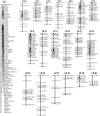An EST-SSR based genetic linkage map and identification of QTLs for anthracnose disease resistance in water yam (Dioscorea alata L.)
- PMID: 30303959
- PMCID: PMC6179188
- DOI: 10.1371/journal.pone.0197717
An EST-SSR based genetic linkage map and identification of QTLs for anthracnose disease resistance in water yam (Dioscorea alata L.)
Abstract
Water yam (Dioscorea alata L.) is one of the most important food yams with wide geographical distribution in the tropics. One of the major constraints to water yam production is anthracnose disease caused by a fungus, Colletotrichum gloeosporioides (Penz.). There are no economically feasible solutions as chemical sprays or cultural practices, such as crop rotation are seldom convenient for smallholder farmers for sustainable control of the disease. Breeding for development of durable genetic resistant varieties is known to offer lasting solution to control endemic disease threats to crop production. However, breeding for resistance to anthracnose has been slow considering the biological constraints related to the heterozygous and vegetative propagation of the crop. The development of saturated linkage maps with high marker density, such as SSRs, followed by identification of QTLs can accelerate the speed and precision of resistance breeding in water yam. In a previous study, a total of 1,152 EST-SSRs were developed from >40,000 EST-sequences generated from two D. alata genotypes. A set of 380 EST-SSRs were validated as polymorphic when tested on two diverse parents targeted for anthracnose disease and were used to generate a saturated linkage map. Majority of the SSRs (60.2%) showed Mendelian segregation pattern and had no effect on the construction of linkage map. All 380 EST-SSRs were mapped into 20 linkage groups, and covered a total length of 3229.5 cM. Majority of the markers were mapped on linkage group 1 (LG 1) comprising of 97 EST-SSRs. This is the first genetic linkage map of water yam constructed using EST-SSRs. QTL localization was based on phenotypic data collected over a 3-year period of inoculating the mapping population with the most virulent strain of C. gloeosporioides from West Africa. Based on threshold LOD scores, one QTL was consistently observed on LG 14 in all the three years and average score data. This QTL was found at position interval of 71.1-84.8 cM explaining 68.5% of the total phenotypic variation in the average score data. The high marker density allowed identification of QTLs and association for anthracnose disease, which could be validated in other mapping populations and used in marker-assisted breeding in D. alata improvement programmes.
Conflict of interest statement
The authors have declared that no competing interests exist.
Figures





References
-
- Food and Agricultural Organization (FAO). FAOSTAT Statistical Division of the FAO of the United Nations Rome, Italy 2010; www.faostat.org
-
- Siqueira MVBM, Dequigiovanni G, Corazon-Guivin MA, Feltran JC, Veasey E. DNA fingerprinting of water yam (Dioscorea alata) cultivars in Brazil based on microsatellite markers. Hortic Bras. 2012; 30 (4): 653–659.
-
- Sartie A, Asiedu R. Segregation of vegetative and reproductive traits associated with tuber yield and quality in water yam (Dioscorea alata L.). Afric J Biotech. 2014; 13 (28): 2807–2818.
-
- Abang MM, Fagbola O, Smalla K, Winter S. Two genetically distinct populations of Colletotrichum causing anthracnose disease of yam (Dioscorea spp.). J Phytopathology. 2005; 153: 137–142.
Publication types
MeSH terms
LinkOut - more resources
Full Text Sources
Research Materials

